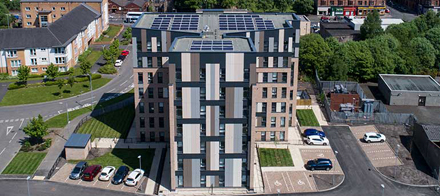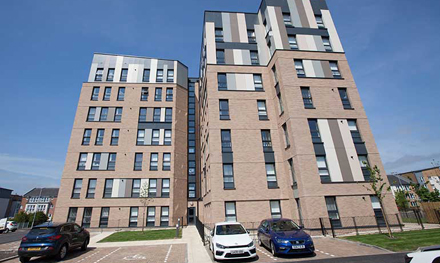
CCG’s recently completed Ellerslie Road development won the Best Social Housing category at the 2018 Structural Timber Awards in the UK. Source: Timberbiz
The seven storey building is built entirely from PEFCTM certifield CLT by Stora Enso and is Scotland’s tallest timber building.
It is also Scotland’s first multi-storey domestic CLT building and the Building Warrant approval has set a precedent in Scotland as a result of evidence supplied to Building Standards Scotland, Glasgow City Council and Scottish Fire & Rescue Services.
Built on the banks of the River Clyde at Yoker, a town just west of Glasgow, Ellerslie Road provides 42 one, two and three bed contemporary mid-market rent apartments.
The new building, which was designed by MAST Architects, optimises the efficiency of CLT with six apartment modules arranged around one central stairway in a ‘T’ shaped form.
Apartments are designed around a standard template used by CCG for all residential units however, CLT’s ability to achieve long, uninterrupted spans allowed for a flexibility in the layout of apartments from floor to floor which would have been more constrained with traditional forms of construction. 
The complete superstructure is built from CLT including the common areas and lift shaft. The lift shaft structural walls are formed by 100 mm thick CLT panels tied together to form a rigid tube with the shaft independent from the CLT separation wall between lobby and apartment.
The CLT shaft is restrained laterally at each of the seven floor levels with the CLT panels forming the lobby slab and capped with a 120mm thick CLT ‘lid’ used to fix the hooks to install the lift without the need for any steel lifting beam.
A bespoke platform is used to support the superstructure due to the lightweight nature of CLT and the exposure to wind loadings along the river.
The superstructure includes design features to provide enhanced resistance to disproportionate collapse and this has encouraged the Institution of Structural Engineers (IStructE) to start a review process for Part A3 – Building Regulation Disproportionate Collapse as it is recognised that there are a number of forms of construction that would benefit from a review.
There was 1240 m3 of CLT used in the construction of Ellerslie Road, which equates to a total of 757 tonnes of CO2 being removed from the earth’s atmosphere.
Other key benefits of building with CLT include the material’s inherent air tightness and thermal properties which mean that residents will benefit from energy savings when compared to traditional methods of construction.
Solar PV panels have also been installed on the roof providing long-term energy savings on residents’ energy bills.
Building with CLT resulted in reduced construction time minimising impact on the surrounding community with the entire seven-storey superstructure installed and wind and watertight in just 16 weeks.
Ellerslie Road is the subject of two academic research programs looking at factors including CLT’s airtightness, acoustics, thermal performance, productivity, LCA/whole life costing and the building’s interaction with wind.







